#local ad
Text
youtube
Nate, Buzz, and Helen as Mario, Luigi, and girl-voiced-by-old-toadstool-actress respectively
#Mario movie#Helen ydkj#ydkj helen#nate shapiro#buzz lippman#super Mario bros super show#on the double#super mario bros movie#Mario Mario#Luigi Mario#local ad#local advertising#local ad-core#cousin moments#the only thing you didn’t drain was my bank account#super mario bros plumbing#Youtube
16 notes
·
View notes
Text


Here’s the two girls from the Eagleman commercial. Why? Why not. If you recognize them you either grew up near me or you are a person of great taste.
1 note
·
View note
Text
First time for everything I suppose
0 notes
Text


Had some fun drawing kitten mittens on stitchfiddle.
#knitting#knitting chart#I tried adding these to Ravelry but they want my name so#enjoy them here#if you feel generous go donate to your local shelter!
497 notes
·
View notes
Text
this disability pride month i'd like to remind y'all that "visibly disabled" does not imply "mobility aid user" (nor anything else other than "people can see there is something about you that doesn't fit abled hegemony")
OP is autistic and talking about its experiences being autistic (AND multiply disabled). don't fucking touch if you have no solidarity towards autistic people.
#cpunk#dyspunktional#disability#disability pride month#neuroqueer#neurodivergence#actually autistic#actually disabled#this is a friendly (ish) reminder from your not-so-local cripple who has been visibly disabled for the last decade or so#and yet doesn't have any access to mobility aids besides one (1) knee brace that doesn't even fully work#adding that disclaimer juuust in case. you know who you are.#physdis#physically disabled#physical disability#unitypunk
3K notes
·
View notes
Text
if you go to an active construction site with lots of heavy machinery and close your eyes you can imagine that’s what gay robot sex sounds like
#yeah okay posting this#inverse problem.txt#suggestive#robophilia#okay seriously though do not try this at home#comply with your local safety regulations#don't walk onto the site unless you have permission and necessary personal protective equipment and knowledge of necessary procedures etc#this post is a joke etc etc#adding all the obligatory disclaimers bc of some of the notes I'm seeing here lol
649 notes
·
View notes
Text

If you're in the greater Seattle area i run a small knife sharpening business! Get your knives sharpened!
#Seattle#will speaks#local businesses#im really happy with my dumb little ad#if you need help preparing for a knife fight with Tom Turkey i'm your guy
999 notes
·
View notes
Text

oh miku vamos aos toiros!!
i've seen a lot of portuguese mikus but not an azorean one so here is my extremely niche contribution to the trend 🐳🐮⛵
#i love how a lot of these end up as inadvertent ads for our local soft drink of choice#hatsune miku#brazilian miku#azorean miku#portuguese miku#azores#my art
207 notes
·
View notes
Text
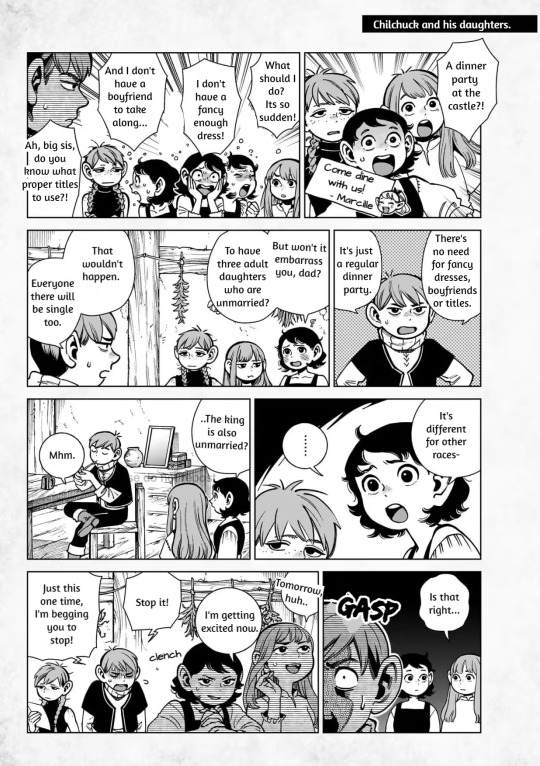
Wait one darn diggity second what’s this about unmarried half-foot women being embarrassing for the family, what’s this about being unmarried as a half-foot being "different [worse than] for other races". Maybe Flertom and Puckpatti’s intensity about finding a husband is the norm, maybe Meijack, despite Chilchuck approving of her disinterest in romance, is the one who’s considered weird by social standards.
Maybe they’re less well-adjusted than I thought. Don’t misunderstand me I’m aroace, but if there’s a lot of societal pressure and it’s considered a failure if you’re not married, it is notable when all 3 of your kids haven’t married past the time that’s expected. For reference adulthood for a half-foot is reached at 14, Chil got married at 13, Puckpatti is 14 while Flertom and Meijack are 16. The other half-foot character we have is Mickbell who is also unmarried, unsurprising considering his situation. I don’t think them not having married is about their family being poorer, if anything I’d think Chil’s family is on the comfier end of half-foot families with the high wages he gets paid with and the nice living conditions we’ve seen (although we don’t know when he started being paid well). We know about Flertom having high standards, but she and Puckpatti are actively looking to date, so there’s something going on here whatever it is.
It is nice that it doesn’t seem like Chilchuck cares at all, he even seems to generally dislike the idea of his daughters dating. I imagine that their mother must have also not pressured them into marrying at all, maybe even encouraged them not to marry if they didn’t have someone, which is sweet. And understandable, considering she might not want her daughters to rush into it and live with…….. Being stuck in an unhappy marriage.
And here comes in what I meant when I said well-adjusted, daddy issues. We aren’t shown a lot of Chil’s married life, but I would bet my life on there having been tensions and warning signs. Especially since, since the daughters and Chil hadn’t seen each other since the separation before post-canon, there’s an air of not having been very surprised or panicked about the whole thing: the separation wasn’t unexpected. Having to watch your parents fall out of love and growing up seeing them in a taxing marriage can be hard, and not exactly put you in the mood to try and find romance and marry. Fear of abandonment, fear of intimacy, stunted emotional intelligence, fear of commitment… Oh girlies I am about to extrapolate so much from this
Half-foot society has a lot of coding I don’t have enough specialized knowledge to pin down, but they’re a poor working class people, anglo peasant vibes. They have tightly knit communities, but then the double edge is that if your community has expectations and rules to belong, the pressure will be harsh and it can end up being more isolating if you deviate from it. Marriage historically and in Dunmeshi has a lot of economical aspects, in Laios’ Adventurer’s Bible profile for example dowries are hinted at.
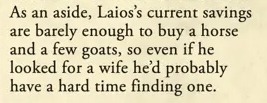
So the pressure to marry might very well originate from the need to bring money in to your family, and to unite families as allies. And from there it grows into an expectation, and thus if they aren’t married it’s "an unmarried woman was deemed unfit by suitors, something with her must be off"/"This woman was unable to provide for her family, she must be a burden on them" which results into the family having a bad reputation. If Flertom says it’s worse for half-foots than other races, the reasons must be either social or economical or both. There’s of course their lifespan being shorter too, so that might play into it, expectations to go about things quickly and to have a fast life cycle and making sure to have kids. As we see with Laios, having kids is a pressure that does exist globally as well. Elves are another interesting example of how familial expectations are like in Dunmeshi with heirdom and whatnot, but free me I just wanted to bring up the possibility of Childaughters being societal misfits and having relational issues.
I will also mention that in a similar way, Chilchuck’s wife leaving him may have damaged the daughters’ chances, in a "what if they’re like their mother, the type of woman to abandon her husband!" way. Chilchuck also has a reputation especially as an union leader, which can paint him as dependable as much as it can paint him as someone harsh and stingy, which would be an intimidating. It’s possible they’re a bit more well-off from the rest of the half-foot community as mentioned, which could add to the intimidating factor or a bad reputation as an overall uptight family or one that has drama. Again, double edge of community being very tightly knit and important, with family as one of its highest values.
#Spoilers#dungeon meshi manga spoilers#Meta#dungeon meshi#chilchuck’s family#Flertom#puckpatti#meijack#fumi rambles#What if Chil’s family truly is considered like the local rich stuck up fam#“The father head of the family is a union man and daughters aren’t even married” they have it so good blabla don’t bring ur business there#Or something#I’ll be adding this to my family masterpost just gimme like a week
201 notes
·
View notes
Text
This is your brain on fraud apologetics
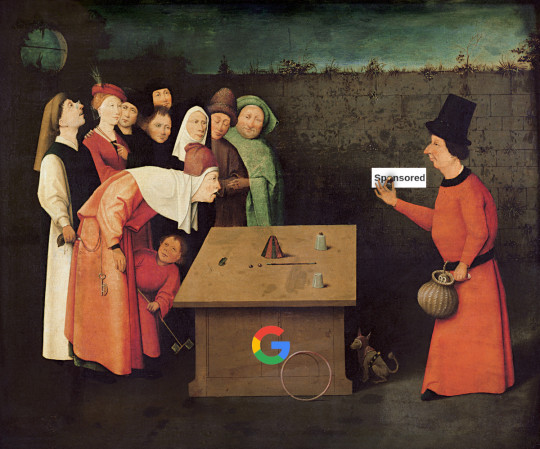
In 1998, two Stanford students published a paper in Computer Networks entitled “The Anatomy of a Large-Scale Hypertextual Web Search Engine,” in which they wrote, “Advertising funded search engines will be inherently biased towards the advertisers and away from the needs of consumers.”
https://research.google/pubs/pub334/
If you’d like an essay-formatted version of this post to read or share, here’s a link to it on pluralistic.net, my surveillance-free, ad-free, tracker-free blog:
https://pluralistic.net/2023/02/24/passive-income/#swiss-cheese-security
The co-authors were Lawrence Page and Sergey Brin, and the “large-scale hypertextual web search-engine” they were describing was their new project, which they called “Google.” They were 100% correct — prescient, even!
On Wednesday night, a friend came over to watch some TV with us. We ordered out. We got scammed. We searched for a great local Thai place we like called Kiin and clicked a sponsored link for a Wix site called “Kiinthaila.com.” We should have clicked the third link down (kiinthaiburbank.com).
We got scammed. The Wix site was a lookalike for Kiin Thai, which marked up their prices by 15% and relayed the order to our local, mom-and-pop, one-branch restaurant. The restaurant knew it, too — they called us and told us they were canceling the order, and said we could still come get our food, but we’d have to call Amex to reverse the charge.
As it turned out, the scammers double-billed us for our order. I called Amex, who advised us to call back in a couple days when the charge posted to cancel it — in other words, they were treating it as a regular customer dispute, and not a systemic, widespread fraud (there’s no way this scammer is just doing this for one restaurant).
In the grand scheme of things, this is a minor hassle, but boy, it’s haunting to watch the quarter-century old prophecy of Brin and Page coming true. Search Google for carpenters, plumbers, gas-stations, locksmiths, concert tickets, entry visas, jobs at the US Post Office or (not making this up) tech support for Google products, and the top result will be a paid ad for a scam. Sometimes it’s several of the top ads.
This kind of “intermediation” business is actually revered in business-schools. As Douglas Rushkoff has written, the modern business wisdom reveres “going meta” — not doing anything useful, but rather, creating a chokepoint between people who do useful things and people who want to pay for those things, and squatting there, collecting rent:
https://rushkoff.medium.com/going-meta-d42c6a09225e
It’s the ultimate passive income/rise and grind side-hustle: It wouldn’t surprise me in the least to discover a whole festering nest of creeps on Tiktok talking about how they pay Mechanical Turks to produce these lookalike sites at scale.
This mindset is so pervasive that people running companies with billions in revenue and massive hoards of venture capital run exactly the same scam. During lockdown, companies like Doordash, Grubhub and Uber Eats stood up predatory lookalike websites for local restaurants, without their consent, and played monster-in-the-middle, tricking diners into ordering through them:
https://pluralistic.net/2020/09/19/we-are-beautiful/#man-in-the-middle
These delivery app companies were playing a classic enshittification game: first they directed surpluses to customers to lock them in (heavily discounting food), then they directed surplus to restaurants (preferential search results, free delivery, low commissions) — then, having locked in both consumers and producers, they harvested the surplus for themselves.
Today, delivery apps charge massive premiums to both eaters and restaurants, load up every order with junk fees, and clone the most successful restaurants out of ghost kitchens — shipping containers in parking lots crammed with low-waged workers cranking out orders for 15 different fake “virtual restaurants”:
https://pluralistic.net/2020/12/01/autophagic-buckeyes/#subsidized-autophagia
Delivery apps speedran the enshittification cycle, but Google took a slower path to get there. The company has locked in billions of users (e.g. by paying billions to be the default search on Safari and Firefox and using legal bullying to block third party Android device-makers from pre-installing browsers other than Chrome). For years, it’s been leveraging our lock-in to prey on small businesses, getting them to set up Google Business Profiles.
These profiles are supposed to help Google distinguish between real sellers and scammers. But Kiin Thai has a Google Business Profile, and searching for “kiin thai burbank” brings up a “Knowledge Panel” with the correct website address — on a page that is headed with a link to a scam website for the same business. Google, in other words, has everything it needs to flag lookalike sites and confirm them with their registered owners. It would cost Google money to do this — engineer-time to build and maintain the system, content moderator time to manually check flagged listings, and lost ad-revenue from scammers — but letting the scams flourish makes Google money, at the expense of Google users and Google business customers.
Now, Google has an answer for this: they tell merchants who are being impersonated by ad-buying scammers that all they need to do is outbid them for the top ad-spot. This is a common approach — Amazon has a $31b/year “ad business” that’s mostly its own platform sellers bidding against each other to show you fake results for your query. The first five screens of Amazon search results are 50% ads:
https://pluralistic.net/2022/11/28/enshittification/#relentless-payola
This is “going meta,” so naturally, Meta is doing it too: Facebook and Instagram have announced a $12/month “verification” badge that will let you report impersonation and tweak the algorithm to make it more likely that the posts you make are shown to the people who explicitly asked to see them:
https://www.vox.com/recode/2023/2/21/23609375/meta-verified-twitter-blue-checkmark-badge-instagram-facebook
The corollary of this, of course, is that if you don’t pay, they won’t police your impersonators, and they won’t show your posts to the people who asked to see them. This is pure enshittification — the surplus from users and business customers is harvested for the benefit of the platform owners:
https://pluralistic.net/2023/01/21/potemkin-ai/#hey-guys
The idea that merchants should master the platforms as a means of keeping us safe from their impersonators is a hollow joke. For one thing, the rules change all the time, as the platforms endlessly twiddle the knobs that determine what gets shown to whom:
https://doctorow.medium.com/twiddler-1b5c9690cce6
And they refuse to tell anyone what the rules are, because if they told you what the rules were, you’d be able to bypass them. Content moderation is the only infosec domain where “security through obscurity” doesn’t get laughed out of the room:
https://doctorow.medium.com/como-is-infosec-307f87004563
Worse: the one thing the platforms do hunt down and exterminate with extreme prejudice is anything that users or business-customers use to twiddle back — add-ons and plugins and jailbreaks that override their poor choices with better ones:
https://www.theverge.com/2022/9/29/23378541/the-og-app-instagram-clone-pulled-from-app-store
As I was submitting complaints about the fake Kiin scam-site (and Amex’s handling of my fraud call) to the FTC, the California Attorney General, the Consumer Finance Protection Bureau and Wix, I wrote a little Twitter thread about what a gross scam this is:
https://twitter.com/doctorow/status/1628948906657878016
The thread got more than two million reads and got picked up by Hacker News and other sites. While most of the responses evinced solidarity and frustration and recounted similar incidents in other domains, a significant plurality of the replies were scam apologetics — messages from people who wanted to explain why this wasn’t a problem after all.
The most common of these was victim-blaming: “you should have used an adblocker” or “never click the sponsored link.” Of course, I do use an ad-blocker — but this order was placed with a mobile browser, after an absentminded query into the Google search-box permanently placed on the home screen, which opens results in Chrome (where I don’t have an ad-blocker, so I can see material behind an ad-blocker-blocker), not Firefox (which does have an ad-blocker).
Now, I also have a PiHole on my home LAN, which blocks most ads even in a default browser — but earlier this day, I’d been on a public wifi network that was erroneously blocking a website (the always excellent superpunch.net) so I’d turned my wifi off, which meant the connection came over my phone’s 5G connection, bypassing the PiHole:
https://pluralistic.net/2022/04/28/shut-yer-pi-hole/
“Don’t click a sponsored link” — well, the irony here is that if you habitually use a browser with an ad-blocker, and you backstop it with a PiHole, you never see sponsored links, so it’s easy to miss the tiny “Sponsored” notification beside the search result. That goes double if you’re relaxing with a dinner guest on the sofa and ordering dinner while chatting.
There’s a name for this kind of security failure: the Swiss Cheese Model. We all have multiple defenses (in my case: foreknowledge of Google’s ad-scam problem, an ad-blocker in my browser, LAN-wide ad sinkholing). We also have multiple vulnerabilities (in my case: forgetting I was on 5G, being distracted by conversation, using a mobile device with a permanent insecure search bar on the homescreen, and being so accustomed to ad-blocked results that I got out of the habit of checking whether a result was an ad).
If you think you aren’t vulnerable to scams, you’re wrong — and your confidence in your invulnerability actually increases your risk. This isn’t the first time I’ve been scammed, and it won’t be the last — and every time, it’s been a Swiss Cheese failure, where all the holes in all my defenses lined up for a brief instant and left me vulnerable:
https://locusmag.com/2010/05/cory-doctorow-persistence-pays-parasites/
Other apologetics: “just call the restaurant rather than using its website.” Look, I know the people who say this don’t think I have a time-machine I can use to travel back to the 1980s and retrieve a Yellow Pages, but it’s hard not to snark at them, just the same. Scammers don’t just set up fake websites for your local businesses — they staff them with fake call-centers, too. The same search that takes you to a fake website will also take you to a fake phone number.
Finally, there’s “What do you expect Google to do? They can’t possibly detect this kind of scam.” But they can. Indeed, they are better situated to discover these scams than anyone else, because they have their business profiles, with verified contact information for the merchants being impersonated. When they get an ad that seems to be for the same business but to a different website, they could interrupt the ad process to confirm it with their verified contact info.
Instead, they choose to avoid the expense, and pocket the ad revenue. If a company promises to “to organize the world’s information and make it universally accessible and useful,” I think we have the right to demand these kinds of basic countermeasures:
https://www.google.com/search/howsearchworks/our-approach/
The same goes for Amex: when a merchant is scamming customers, they shouldn’t treat complaints as “chargebacks” — they should treat them as reports of a crime in progress. Amex has the bird’s eye view of their transaction flow and when a customer reports a scam, they can backtrack it to see if the same scammer is doing this with other merchants — but the credit card companies make money by not chasing down fraud:
https://www.buzzfeednews.com/article/rosalindadams/mastercard-visa-fraud
Wix also has platform-scale analytics that they could use to detect and interdict this kind of fraud — when a scammer creates a hundred lookalike websites for restaurants and uses Wix’s merchant services to process payments for them, that could trigger human review — but it didn’t.
Where do all of these apologetics come from? Why are people so eager to leap to the defense of scammers and their adtech and fintech enablers? Why is there such an impulse to victim-blame?
I think it’s fear: in their hearts, people — especially techies — know that they, too, are vulnerable to these ripoffs, but they don’t want to admit it. They want to convince themselves that the person who got scammed made an easily avoidable mistake, and that they themselves will never make a similar mistake.
This is doubly true for readerships on tech-heavy forums like Twitter or (especially) Hacker News. These readers know just how many vulnerabilities there are — how many holes are in their Swiss cheese — and they are also overexposed to rise-and-grind/passive income rhetoric.
This produces a powerful cognitive dissonance: “If all the ‘entrepreneurs’ I worship are just laying traps for the unwary, and if I am sometimes unwary, then I’m cheering on the authors of my future enduring misery.” The only way to resolve this dissonance — short of re-evaluating your view of platform capitalism or questioning your own immunity to scams — is to blame the victim.
The median Hacker News reader has to somehow resolve the tension between “just install an adblocker” and “Chrome’s extension sandbox is a dumpster fire and it’s basically impossible to know whether any add-on you install can steal every keystroke and all your other data”:
https://mattfrisbie.substack.com/p/spy-chrome-extension
In my Twitter thread, I called this “the worst of all possible timelines.” Everything we do is mediated by gigantic, surveillant monopolists that spy on us comprehensively from asshole to appetite — but none of them, not a 20th century payment giant nor a 21st century search giant — can bestir itself to use that data to keep us safe from scams.
Next Thu (Mar 2) I'll be in Brussels for Antitrust, Regulation and the Political Economy, along with a who's-who of European and US trustbusters. It's livestreamed, and both in-person and virtual attendance are free:
https://www.brusselsconference.com/registration
On Fri (Mar 3), I'll be in Graz for the Elevate Festival:
https://elevate.at/diskurs/programm/event/e23doctorow/
[Image ID: A modified version of Hieronymus Bosch's painting 'The Conjurer,' which depicts a scam artist playing a shell-game for a group of gawking rubes. The image has been modified so that the scam artist's table has a Google logo and the pea he is triumphantly holding aloft bears the 'Sponsored' wordmark that appears alongside Google search results.]
#pluralistic#victim blaming#fraud#going meta#douglas rushkoff#ad-tech#local search#wix#amex#thai food#business#rent-seeking#entrepreneurship#passive income#chokepoint capitalism#platform lawyers
2K notes
·
View notes
Text
my body is a machine that turns anything into ultrakill



#krizzia.txt#things to tide me over before V1 plushie#V1 PLUSHIE COME HOMEEEEEEEEEEEEEEEE#ok adding tags to clear things up: i didnt do anyt of these i commissioned them from local shops i cant do crafts for shit
112 notes
·
View notes
Text

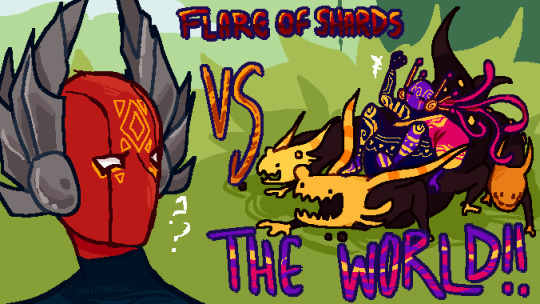

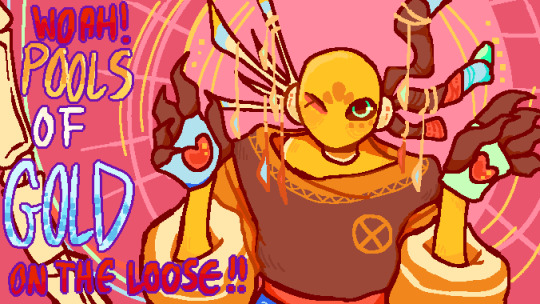

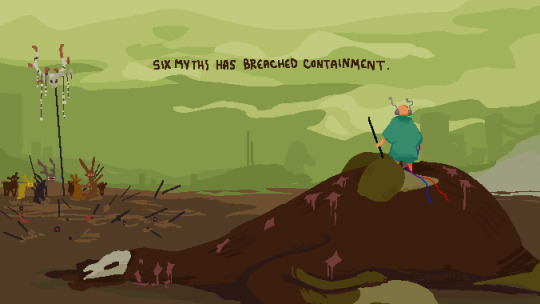
just like. a ton of thumbnail drawings i made for all my iterators and their skin mods :]
#these didn't take too long actually#the most tedious one was myths' due to the composition#i hope the symbolism I'm trying to go for is clear in these#i just love sneaking meanings into everything !#super happy with prosperity's thumbnail !!!#rainworld#rain world#art#rw iterator#iterator oc#flare of shards (fos)#six myths (sm)#boundless prosperity (bp)#fields(comma) vast and fruitful (fvaf)#rainworld art#mod stuff#pools of gold (pog)#for the record#pog is not apart of the local group. I'm just adding them in because i drew their thumbnail as well :]#because they are my sona... i had to make a skin BAHAH
394 notes
·
View notes
Text

This is about a show that was saved by Netflix a few years ago. This is the article about it (I recommend it!)
So, about the viewing.
We're already doing good, the show went back to top 20 and now 30 according to televisionstats, but we need new viewers. The thing we've been doing until now, but more.
What do we think about actually doing a marketing effort? As in, with ads and everything? Mostly online probably, but with fundraising either way. The billboard thing seems nice but not just that.
I'm not from the US or UK so this is an idea that I could help plan only to an extent. But I'm really wondering, because as a group we may be able to do the marketing Netflix didn't. Not just as in "save the show' but "WATCH the show"!
I'm thinking artists and editors to make the content, someone with performance knowledge to make the campaigns, and targetting audiences across platforms — YouTube, TikTok, Twitter, Instagram, etc.
Is this something?
#so many people work with social media ads I'm sure there are some in the fandom#financially I could only help locally because of the exchange rate but still#this could be organized if ya'll think it's worth it#dead boy detectives#dbda#save dead boy detectives#renew dead boy detectives
104 notes
·
View notes
Text
I love it when he’s undermined by reality.
0 notes
Text
My best friend and I had a call recently---she’s back with her family for a bit helping out with some hometown stuff. As part of the stuff, she’s been going through a (deceased) relative’s scrapbook, compiled in the American Midwest circa 1870-1900 and featuring mostly cut-out figures from the ads of the day.
She talked about how painstaking this relative’s work was. (Apparently the relative was careful to cut out every finger, every cowlick; this was by no means carelessly or hastily assembled.) But she also she talked about how---the baby on the baking soda ad is ugly, it is so ugly, why anyone would clip this heinously ugly illustrated baby and paste it into a scrapbook? Why would you save the (terribly told, boring) ghost story that came with your box of soap?
(Why include these things in the first place? we asked each other. ”There’s a kind of anti-capitalism to it,” she mused.)
And we discussed that for a bit---how most of the images, stories, artists, and ads were local, not national; they’re pulled from [Midwestern state] companies’ advertisements in [Midwestern state] papers, magazines, and products. As a consequence, you’re not looking at Leyendecker or Norman Rockwell illustrations, but Johann Spatz-Smith from down the road, who took a drawing class at college.
(College is the state college, and he came home on weekends and in the summer to help with the farm or earn some money at the plant.)
But it also inspired a really interesting conversation about how---we have access to so much more art, better and more professional art, than any time in history. As my bff said, all you have to do to find a great, technically proficient and lovely representational image of a baby, is to google the right keywords. But for a girl living in rural [Midwestern state] of the late 1800s, it was the baking soda ad, or literal actual babies. There was no in-between, no heading out to the nearby art museum to study oil paintings of mother and child, no studying photographs and film---such new technologies hadn’t diffused to local newspapers and circulars yet, and were far beyond the average person’s means. But cheap, semi-amateur artists? Those were definitely around, scattered between towns and nearby smallish cities.
It was a good conversation, and made me think about a couple things---the weird entitlement that “professional” and expensive art instills in viewers, how it artificially depresses the appetite for messy unprofessional art, including your own; the way that this makes your tastes narrower, less interesting, less open.
By that I mean---maybe the baby isn’t ugly! Maybe you’ve just seen too many photorealistic babies. Maybe you haven’t really stopped to contemplate that your drawing of a baby (however crude, ugly, or limited) is the best drawing of a baby you can make, and the act of drawing that lumpen, ugly baby is more sacred and profoundly human than even looking at a Mary Cassatt painting.
And even if that isn’t the case....there was this girl in [American Midwestern state] for whom it was very, very important that she capture every finger, curl, and bit of shading for that ugly soap ad baby. And some one hundred years later, her great-something-or-other took pains to preserve her work---because how terribly human it is, to seek out all the art we can find that resonates with us, preserve it, adore it.
It might be the most human impulse we have.
#I of course went on a tangent about henry darger because I love darger and he was also pulling/tracing/finding inspiration in local ads#I was also thinking of the scenes in banshees of inisherin where gleeson plays the fiddle in the bar and the woman sings#clearly not professional! nowhere near mozart.#but you know what? those people are making art. they are engaged in the most human thing you can possibly do#my mother once talked about how when she was growing up in the chicago area the irish immigrants would sing and play at parties#and her mother (one generation removed from immigration) would scoff#because who did they think they were! they weren't professionals. they were making a spectacle of themselves.#''and then it died out. no one sings and plays at parties anymore'' she said quietly#celestial emporium of benevolent knowledge
3K notes
·
View notes
Text
Okay. I've been playing Tokyo Debunker today, since the release happened to catch me on a day when all I'd planned to do was write fanfiction. I just finished reading the game story prologue (it was longer than expected!), so here's a review type post. If you're reading this post not having seen a single thing about this game: it's a story-based joseimuke gacha mobile game that just released globally today. It's about a girl who suddenly finds herself attending a magic school and mingling with elite, superhuman students known as ghouls. If you look in the tumblr tag for the game you'll see what appears to be a completely different game from 2019 or so: they retooled it completely midway through development, changing just about everything about it due to "escalating competition within the gaming industry."

I'll talk about how this looks like a blatant twst clone at the end.
Starting with the positive: The story is charming. I enjoyed it thoroughly the entire time and am excited to read more. The mix between visual novel segments and motion comics was really nice--it broke things up and added a lot of oomph to the action or atmospheric scenes that visual novels generally lack. I like the art in the comic parts a lot. the live2d in the visual novel parts is... passable. Tone-wise, I think the story was a little bit all over the place and would like to see more of the horror that it opened on, but I didn't mind the comedic direction it went in either. The translation is completely seamless. The characters so far all have unique voices and are just super fun and cute. Of the ones who've had larger roles in the story so far, there's not a single one I dislike. It's all fully voiced in Japanese and the acting is solid. (I don't recognize any voices, and can't seem to find any seiyuu credits, so it seems they're not big names, but they deliver nonetheless.) Kaito in particular I found I was laughing at his lines a ton, both the voicing and the writing.

He's looking for a girlfriend btw. Spreading the word.
The problem is like. The gameplay is the worst dark-pattern microtransaction-riddled bullshit I've ever seen. Hundred passive timers going at all times. Fifty different item-currencies. Trying to get you to spend absurd amounts of real world money at every turn. There's like five different indicators that take you to various real-money shop items that I don't know how to dismiss the indicator, I guess you just have to spend money, wtaf. Bajillion different interlocking systems mean you have zero sense of relative value of all the different item-currencies. I did over the course of the day get enough diamonds for one ten-pull, which I haven't used yet. Buying enough diamonds for a ten-pull costs a bit under $60 (presumably USD, but there's a chance the interface is automatically making that CAD for me--not gonna spend the money to check lmfao), with an SSR rate of 1%. BULLSHIIIIIT.

There's like a goddamn thousand-word essay explaining the dozen different types of character upgrades and equippables and equippables for the equippables!! Bad! Bad game design! That's just overcomplicating bullshit to trick people into thinking they're doing something other than clicking button to make number go up! That is not gameplay!
In terms of the actual gameplay, there is none. The battle system is full auto. There might be teambuilding, but from what I've seen so far, most of that consists of hoping you pull good cards from gacha and then clicking button to make number go up. There's occasional rhythm segments but there's no original music, it's just remixes of public domain classical music lmao. I'd describe the rhythm gameplay as "at least more engaging than twisted wonderland's," which is not a high bar

At least there's a cat in the rhythm bit.
And like, ok, I gotta remark on how derivative it is. Like I mentioned in my post earlier, this game is unabashedly aping twisted wonderland's setting and aesthetic. (That said, most of the stuff it steals from twst is magic school stuff that twst also basically stole from Harry Potter, so...?) However, it isn't exactly like twst: in this one, the characters say fuck a lot and bleed all over the place and do violence. Basically, the tone is a fair bit more adult than twst's kid-friendly vibe. (Not, like, adult adult, and I probably wouldn't even call it dark--it's still rated Teen lol. Just more adult than twst.)
Rather than just being students at magic school, the ghouls also go out into the mundane world to go on missions where they fight and investigate monsters and cryptids. Honestly, the magic school setting feels pretty tacked-on. The things that are enjoyable about this would've been just as enjoyable in about any other setting--you can tell this whole aspect was a late trend-chasing addition, lmao. So, yeah, it's blatantly copying twst to try to steal some players, but... Eh, I found myself not caring that much. Someone more (or less) into twst than me may find it grating.
Character-wise, eh, sure, yeah, they're a bit derivative in that aspect too, but it's a joseimuke game, the characters are always derivative. Thus far the writing & execution has been solid enough that I didn't care if they were tropey. If I were to compare it to something else, I'd say the relationship between the protagonist and the ghouls feels more like that of the sage and wizards in mahoyaku than anything from twst. There's some mystery in exactly what "ghouls" are and their place in this world that has me intrigued and wanting to know more about this setting and how each of the characters feels about it. I have a bad habit of getting my hopes up for stories that put big ideas on the table and then being disappointed when they don't follow through in a way that lives up to my expectations, though.
So, my final verdict: I kind of just hope someone uploads all the story segments right onto youtube so nobody has to deal with the dogshit predatory game to get the genuinely decent story lol. Give it a play just for the story if you have faith in your ability to resist dark patterns. Avoid at all costs if you know you're vulnerable to gacha, microtransactions, or timesinks.
#suchobabbles#Tokyo Debunker#it's a global simultaneous release so I'm curious to see how it ends up doing in Japan#it's gonna be competing directly with stellarium of the fragile star which releases in a few days lmao. and is about a magic alchemy school#looks like the two games twt accounts have a similar number of followers#and then theyre competing with bremai releasing in may...#also adding this at the very end since i cant confirm anything:#but i found out abt this game bc it was rt'd by the former localization director/translator of A3en#i dont know if she worked on it or maybe her friend or maybe shes just hype! who knows! but i think her word (or rt) is worth something
167 notes
·
View notes